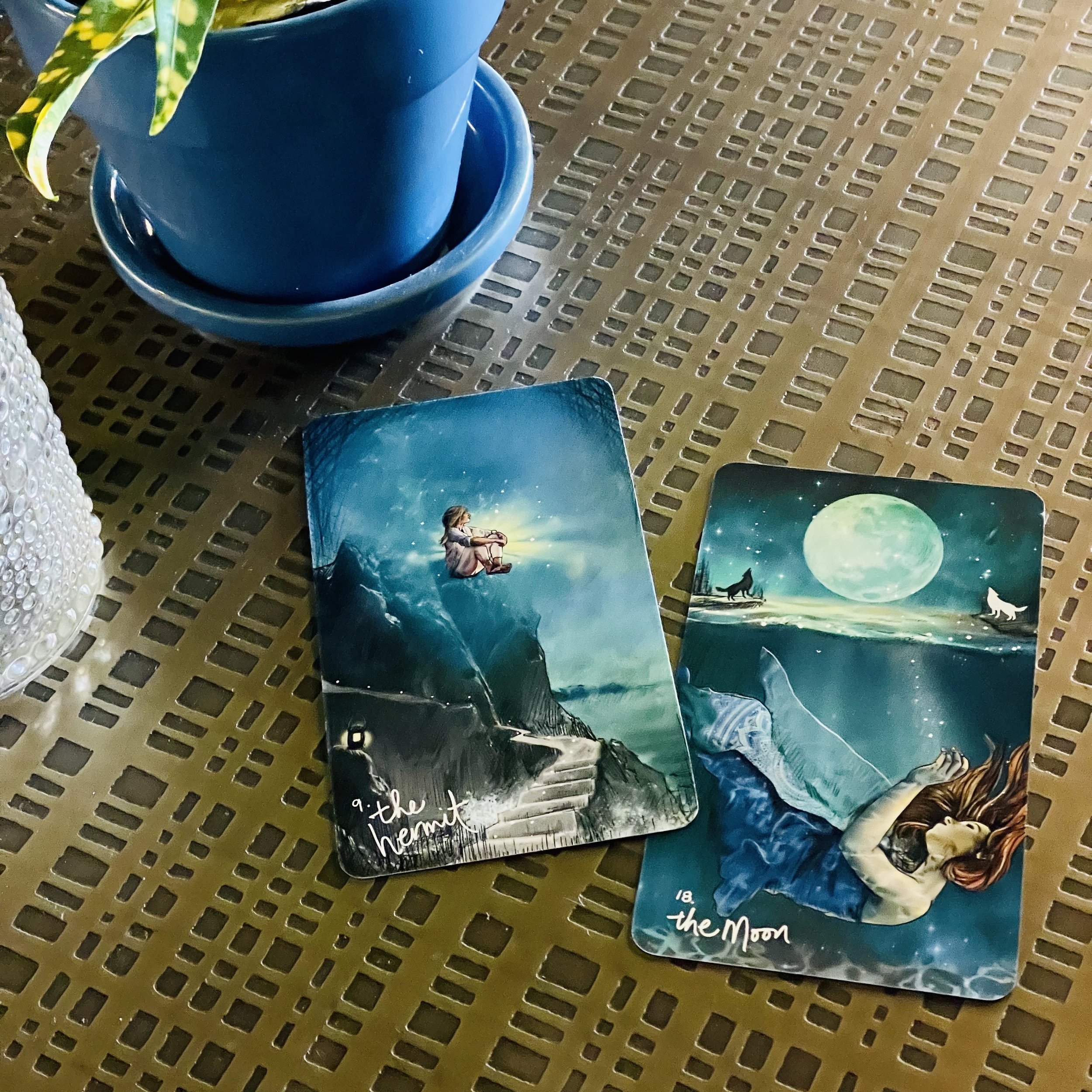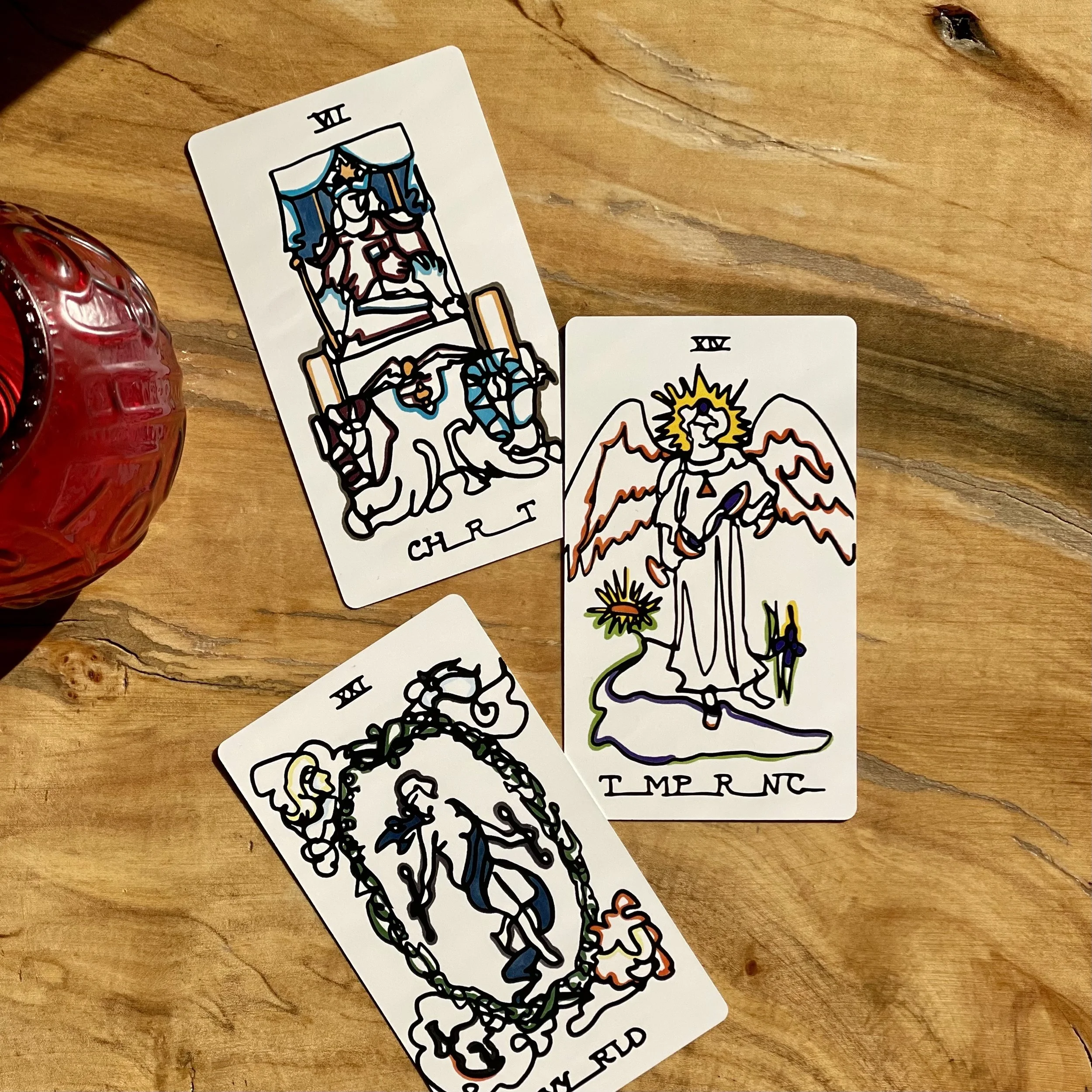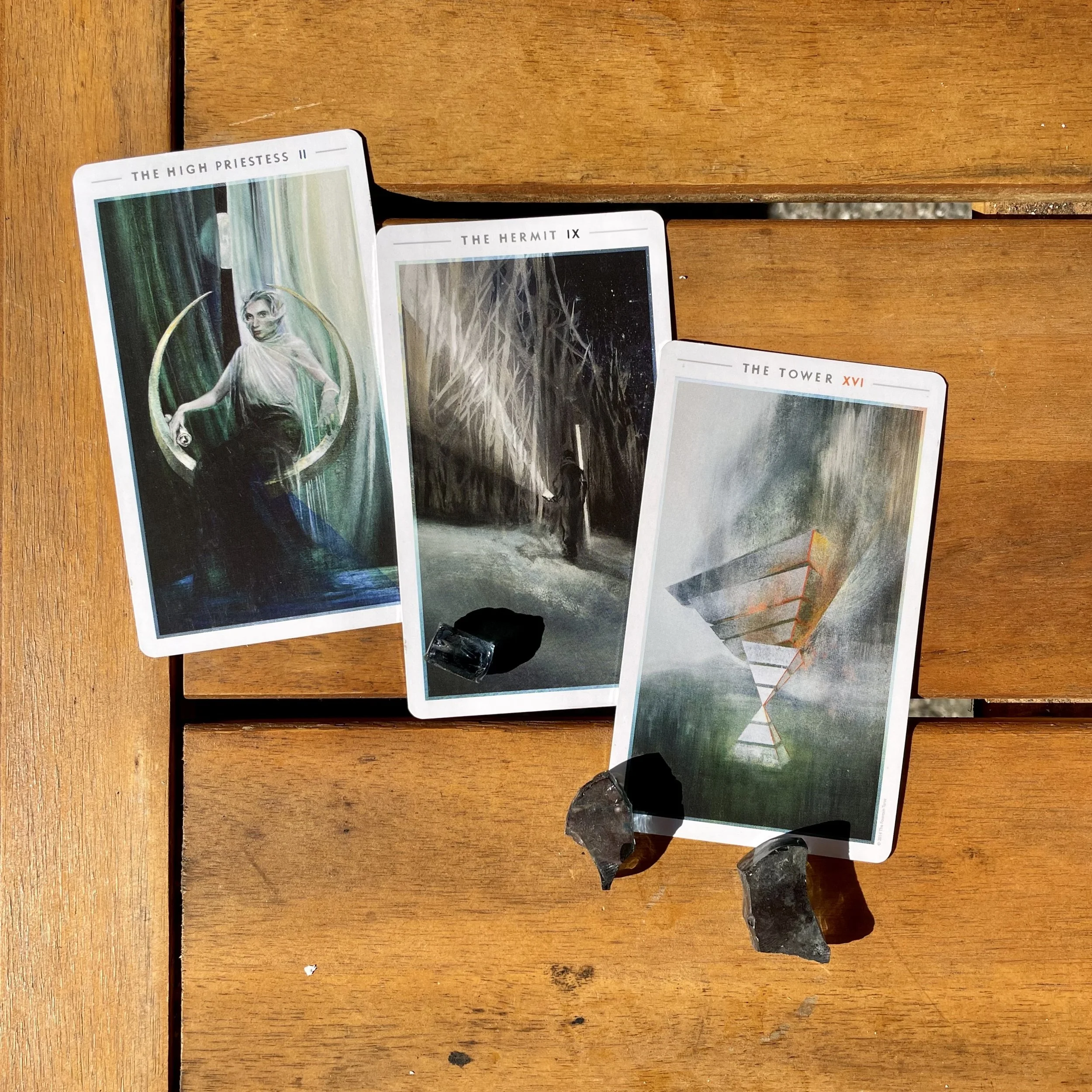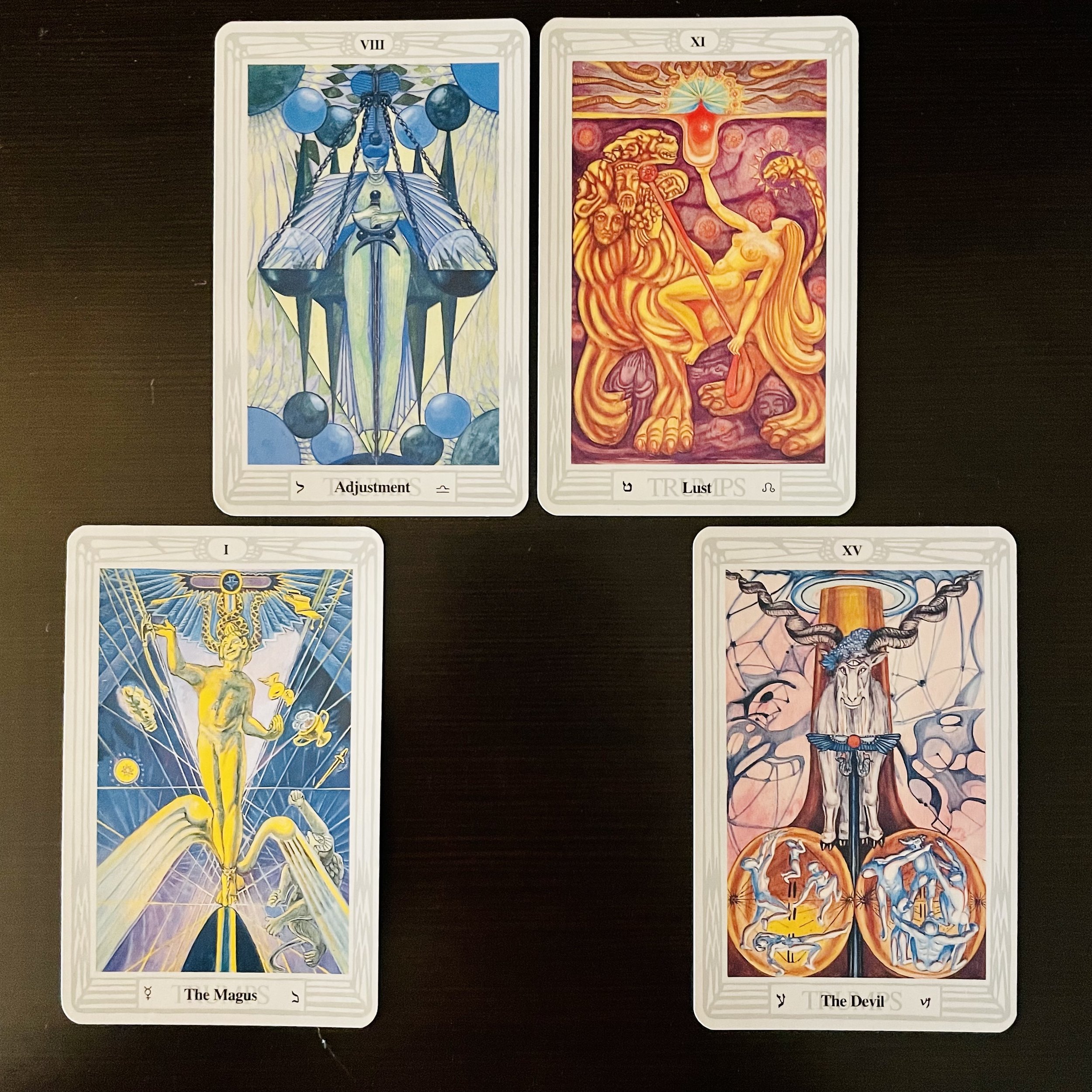Tarot Numerology: Pythagorean vs Septenary
Or if 7 ate 9?
Numerology can be a useful framework for those of us tarot readers who like interpretation systems that goes beyond individual decks’ artistic interpretations. It presents an especially fun mental exercise for those who want to break away from the “traditional” (i.e., Rider/Waite-Smith) interpretations of the minor arcana.
It’s also a useful way of providing a flexible framework to the sometimes arbitrary strict or purely intuitive methods of reading playing cards! As a Vulcan deconstructionist, I love a flexible framework, so I’m super excited for the new Witch’s Book of Numbers by Rebecca Scolnick. The tradition explored uses the single-digit Pythagorean system of reducing numbers to one number, 1–9, and that’s a very familiar and useful system of brining numerology into tarot for me. When I did the first set of “Learning to Read the Major Arcana Better” series, number was an important factor, and it comes into my Read Tarot like a Nerd course.
The Hermit (9) and the Moon (18), both forms of 9 in the major arcana, from the Light Seer’s Tarot by Chris-Anne.
If you’ve read Mary K Greer’s Tarot for Your Self or Archetypal Tarot, you know how some of this works. Major arcana that share a reduced single digit have complementary and/or overlapping lessons to teach us. (The perfect example is the Lovers and Devil as forms of 6.) Such a major-focused method can be really powerful. You can see the reflective nature of, say, the Hermit (9) and the Moon (18 —> 1+8 = 9). Both shine light in the dark places (physically and mentally) and they are both at the end of some inner culmination. Because I’m a life path number 9 and destiny number 9, that’s actually why I chose Hermit’s Mirror (Moon as the Sun’s Mirror) for my mystical moniker.
(That I am a Virgo Moon is only a more recent revelation and beautiful confirmation for me of the choice I made when I thought I was a Leo Moon. Fun fact: I thought about changing my name to Leo Moon Rising but didn’t know why, and it turned out my rising sign was Leo, not Capricorn as I thought. It’s a long story, which you can read on the blog.)
List of Numerological Mirrors in Tarot
Magician, Wheel of Fortune, and Sun
High Priestess, Justice, and Judgment
Empress, Hanged Man, and World
Emperor, Death, and Fool (as 22)
Hierophant and Temperance
Lovers and Devil
Chariot and Tower
Strength and Star
Hermit and Moon
But as useful as it is to see the pattern of the numerological mirrors in tarot (hello, control and catastrophe in the 7s!), it’s good to get outside of tarot to explore the numerology first and then bring it back to your cards and see what gets revealed. That’s especially helpful for the minor arcana! And I think that’s what Scolnick’s book will help me/us do, so I’m definitely going to be exploring her concepts in greater depth than my own haphazard ad-hoc study has provided.
For a quick, free lesson on how to apply number and suit to read the minor arcana better, download my Life Line Tarot Card Interpretation Guide. It’s quick because it’s based on the aforementioned ad-hoc study of numbers!
I haven’t received my pre-order of the book yet as of this writing, but I was listening to an interview with Scolnick about the book on the In Search of Tarot podcast when I got curious to explore something I’ve been putting off. The host Nick explained how he likes to use the 1–9 system in tarot more than the septenary (1–7) system that is baked into some esoteric philosophy used when interpreting the cards.
The septenary system creates three rows of seven columns, where the Fool journeys through the first seven, then the next, and finally the last seven—a structure I offer as an advanced option in my Tarot Tableau system.
The septenary “columns”
Magician, Strength, and Devil
High Priestess, Hermit, and Tower
Empress, Wheel of Fortune, and Star
Emperor, Justice, and Moon
Hierophant, Hanged Man, and Sun
Lovers, Death, and Judgment
Chariot, Temperance, and World
The Chariot (7), Temperance (14), and the World (21), the final cards of each septenary, from my own Life Line Tarot: Color Outside the Lines.
In general terms, it helps identify patterns in the three sets of seven:
the external person/embodied persona nature of the first seven cards (Magician–Chariot);
the development of abstract inner qualities of the second seven cards (Strength–Temperance); and
the cosmic external forces of the final seven (Devil–World).
Neat, right?
But more specific that, it can be tough to see. I actually tend to gloss over the system in my lesson on the major arcana after explaining how you can see the application of individual force in the first column (Magician, Strength, and Devil) and the maturation of controlled, unified power in the final column (Chariot, Temperance, and World). Lindsay Mack of Tarot for the Wild Soul has several podcast episodes about these “lines of the tarot” (you can listen or read the transcript to the first one here). Beyond that, it’s sort of a giant shrug.
Except maybe it’s not.
Because I’m self-reflective, I want to explore the second column first: that’s where the Hermit lies. It’s the column of High Priestess, Hermit, and Tower. I think it’s pretty easy to see the High Priestess and Hermit sharing overlapping themes of teaching and inner wisdom. But then the Tower comes in to wreck it all, naturally. It’s important here to remember that the Tower wasn’t always just some lightning-struck disaster. It was the House of God (Maison-Dieu), or the Tower of Babel, where human knowledge dared to reach into the ineffable divine.
The High Priestess, Hermit, and Tower, the 2s of the septenaries, from the Fountain Tarot by Jonathan Saiz, Jason Gruhl, and Andi Todaro.
In many ways, the Priestess and the Hermit are on an inner quest to uncover divine wisdom that is really the provenance of the gods. What is bestowed on them is what they get. They can’t force their way closer. And if they dare to try, the lightning (or the breath of God) strikes them down for their mortal hubris. Instead, they cultivate inner wisdom and reach for spiritual understanding by going deep within, not by reaching up into the heavens. And importantly, they don’t reveal everything they know! The Priestess is a keeper of secrets, and the Hermit is hard to find. They know better than sharing that knowledge with the masses. And to think, we always blame the Hierophant for gate-keeping. It’s just more based in social control for the Hierophant than for the Priestess and Hermit. For them, it’s about self-preservation.
Okay, so maybe the others are still a big shrug for now because I haven’t spent a ton of time thinking about them. But I do think that we can make meaning from them, and that in itself is a useful exercise. Whether those meanings prove useful in your tarot readings is something only you can discover and only after you’ve practiced with them. Benebell Wen explains the columns in the “Theosophic Septenaries” as different forms of wisdom in her Medium White Book (the guide for her Spirit Keeper’s Tarot ). But I don’t know how helpful those will be, at least not in comparison to thinking about these things for yourself. Don’t get me wrong: they are super interesting. But I don’t personally understand them all that well. Of course, that’s part of the point.
To help get you started in exploring what these groupings might mean for you, here are my initial thoughts.
The third group of the Empress, the Wheel of Fortune, and the Star all suggest indirect, unseen control. The Empress is, historically speaking, usually not the “real” ruler of an empire. More often than not, she has been the woman behind the throne, and that gives her enormous but indirect power. Similarly, the Wheel of Fortune concerns the universal flow of energy and its balance, through karma. It follows a cycle that may not be on the same timeline as us mere mortals. There are forces at work, but they’re largely unseen, and the cause and effect may be so far apart that they gone unnoticed. But they’re there all the same. And I think the Star, as a card of heavenly guidance, is similar. The influence of the planetary bodies and stars may sometimes feel very direct, such as when your computer crashes during Mercury Retrograde, but in reality, astrology and the “as above, so below” process of heavenly workings, are often much more subtle. They work through metaphor and analogy, sympathetic correspondence, and by shifting possibility but not creating outcomes. They change the environment and the atmosphere, but they don’t exert direct control. (The Empress as Mother Nature might have a very different lesson.) I’m not sure if that’s useful to understanding the 3s in some way, but it’s a theme all three of these cards in the third column share.
The fourth group of the Emperor, Justice, and the Moon feels like a headache. The Emperor and Justice are so clear and unambiguous, while the Moon is such a trickster. It does seem to be about decision-making in some way, of having clarity and of the shift to confusion as things become bigger than the self. There’s confidence, the weighing of others in decision-making, and then just confusion as the weight of everything beyond one’s immediate control becomes too much. But then I could see something with the way that others exert control on us: directly as people with power, legally or through institutions, and then simply through deceit. But I don’t really love that either. There could be something around authority/self-confidence, external objectivity, and fantasy (or maybe just the unconscious/irrationality) too. Lots to dwell on, but nothing that feels quite coherent enough. Maybe it’s about the things that affect how we think and feel and behave, how we exert our will (similar to the first column). There’s a desire for autonomy, and we assume that we are being rational and impartial, but then there is actually this powerfully irrational and subjective part of us. It’s like the forces guiding me from within, in contrast to the third group, which was external.
The fifth group with the Hierophant, Hanged Man, and Sun definitely feels like external, direct systems of control with the punished Hanged Man and the controlling astrological influence of the Sun, the divine father. I know that the Emperor is historically the one making life and death decisions, but the Hierophant (Pope) is the one making afterlife decisions, which seems more important somehow. But there could simply be a shared story of enlightenment: through official channels, through personal suffering, and through self-liberation and direct communion with Source. It’s interestingly increasingly about stepping out from the dogma and from official recognition. That has a kind of “story” feel to it or a progression. Perhaps it would be better to say that these cards are all ways of connecting with divinity. The Hierophant acts as a human channel for the divine, an intermediary for us. The Hanged Man demonstrates that in the process of suffering, our eyes are opened to divinity. And the Sun shows that it is in the natural world all around us, pure and direct. We don’t have to wait for others to grant us access or suffer through contorted rituals and practices to get there.
The sixth group is very much a story of self in relation to spirit, outside of the boundaries of organized religion. The Lovers is a card of individuation, of identifying who one is in contrast and complementary with another, as well as what one wants. With its ties to desires, there could be a material desire component and real corporeality that’s being pulled out of this card. That’s actually quite fitting for the Lovers in Eden that are depicted in the Smith illustrations. This physical establishment of the self is all thrown out the window with Death, which is a card of ego death and the realization that what one wants and who one is doesn’t really matter. That then opens one up to the possibility of rebirth in Judgment, where the soul is freed from the body’s confines and there is not really an ego left because it’s finally made it to the point of revelation and pure spirit. Now, that’s also more of a journey than a shared theme, but the three cards could be said to share the theme of material–spiritual division. This fits better with the idea of temptation in the Lovers than individuation. And together, the three feel like they’re saying you can’t have both: you have to choose one or the other; you have to live in this world or the next; you can be spiritually pure and connected or a dirty mortal. Of course, all three cards are also, in some way, about identity. There’s who you think you are and want to be, who your gravestone and mortal body say you are, and who you are when you are awakened to your full spiritual self. Much to dwell on.
For someone interested in structures, as I am. I’m left wondering, why would this be a useful structure? Is the transition from a lesson about personally directed will/force to a lesson about the limits of human knowledge valuable? Probably. If I see the third group as directing my attention to unseen external forces affecting me and the fourth about the factors that guide me from within, does that get me anything? Maybe in contrast. These then lay the groundwork for the bigger picture about connection with the divine and about finding my authentic identity within that before coming to mastery and manifestation. But I won’t lie. It feels like I’m really forcing it. Instead, it’s more interesting to pair (or triple) cards together and try to find patterns and shared concerns. I don’t need to use a number system to do so, but maybe there’s something to the sacredness of seven (a very important number in Western spirituality).
Perhaps the bigger and more important question is: Will I use these in my readings? Will they help make my readings better, more powerful, or more effective?
I don’t know. I highly doubt that I will incorporate them in any conscious way (unless there is some septenary pattern happening). But this new constellation will surely seep into my brain in a subconscious way and enrich the cards’ meanings in my mind because I’ve done the work of thinking about the cards more than I would if I just read about this system. Nothing beats the tarot wisdom you can gain from reflecting and ruminating on what someone else has tried to teach you. There’s no shortcut to inner wisdom because you’ll always have to incorporate what you learn. You’ll always have to bring it into you.
The Magus (1) and Devil (15), the first of their septenary, from the Thoth Tarot with the Adjustment (8) and Lust (11) cards .
And the much smaller, potentially more annoying question for me is: How does this change if I flip the positions of Strength and Justice?
And I am a-okay admitting that I don’t have the mental energy to answer this right now. I’m just going to sit with the first round of exploring I’ve done and see how that resonates over the next few weeks and months. Maybe I’ll tackle all this later or not at all. There’s always so much more to learn and think about with tarot that it’s silly to promise to invest time in anything that doesn’t speak to you. If you let yourself be open and curious, you’ll probably be drawn to something else soon enough.
Did you learn something?
If so, you may love my intensive fundamentals course for new and experienced tarot readers, Read Tarot like a Nerd. A new 5-week live session of the course is starting up January 18, and the self-paced version is available all year-round.




